This route heads inland from the Adriatic coast along one of Europe's most historic roads and takes in stretches of both the Marche and a brief visit to neighbouring Umbria. Ancient arches, bridges, walled garrison towns and even a Roman tunnel, still in use today, litter its path.
The Flaminian Way was built by the Roman Consul Gaius Flaminius in 220 BC and was one of Ancient Rome's most important highways, used by its great armies marching to the northern reaches of the Empire. Its importance continued into the Middle Ages when the Papal States valued it as a strategic highway and as a pilgrim route to the shrine of St Francis at Assisi.
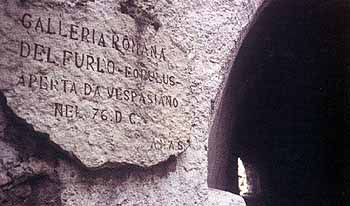
But interesting sights along the way are not limited to archaeological ruins. At Fano, the tour's starting point, you can dip your toe in the sea and window shop in the smart streets of the beguiling old town. Between Fossombrone and Cagli you can admire the breathtaking Furlo Gorge, the scenic highspot on the route. This stretch runs parallel to a modern superstrada that has cleared the ancient road of all but local traffic. If time is short, however, you can use the modern dual-carriageway to hop between attractions. Shortly after the fine old town of Cagli the road crosses the Umbrian border. Here you can make a short detour to Gubbio, one of Italy's finest medieval cities.
Culinary delights on the route begin with the excellent fish at Fano - the vongole, or baby clams, are splendid in a plate of spaghetti. The small town of Acqualagna is noted for its truffles and up in the mountains the prized porcini mushrooms are abundant.
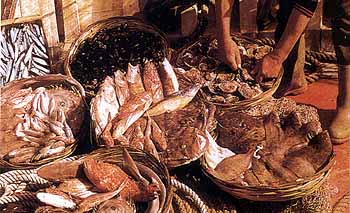
Pesca in Adriatico
The Route
Part I - Fano to the Furlo Gorge to Pontericcioli
The magnificent Roman arch built by the Emperor Augustus at Fano marks the point where the Via Flaminia, or Flaminian Way reaches the Adriatic from Rome. Before setting out on the journey take time to explore this attractive old town and seaside resort. Fano is an unassuming but lively seaside resort, a busy fishing port and an ancient town with a beguiling old centre.
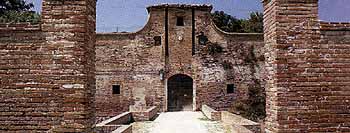
Quattrocentesca corte malatestiana - Fano
The Roman colony of Fanum Fortunae took its name from a noted temple to the goddess of Fortune that once stood here. Still today Fortune reigns, but in the Christian guise of the town's patron, San Fortunato. In Roman times the place was both an important port and cross-road where the Via Flaminia from Rome met the main coastal route.
The Arco di Augusto, a splendid Roman triumphal arch, provides a fitting gateway to the town. It was erected in 2 AD under orders of the Roman Emperor Augustus as part of his ambitious project to smarten up the Empire's road network and marks the arrival of the Via Flaminia on the shores of the Adriatic; on the wall of the church on the right outside the arch is a 16thC bas-relief showing the arch as it was originally built.
From here the main Via Arco di Augusto sets a course through the old centre (if you keep following the road it will eventually take you across the railway tracks to finish on the Sassonia beach). At the main cross-road in the centre turn right up Corso Matteotti to arrive at central Piazza XX Settembre decorated with a whimsical 16thC fountain topped by the goddess Fortune. The arcaded Teatro della Fortuna standing to one side, is the town's recently restored 19thC theatre - an excellent example of the miniature opera-house style stuccoed theatres that dot the Marche.
The other notable building that flanks the square is the Palazzo Malatesta. The palace holds the town's Museo Civico and Pinacoteca, a mixed collection including some fine Renaissance medals and paintings by Guercino, Guido Reni and Michele Giambono. The striking courtyard and loggia of the palace, known as the Corte Malatestiana, hosts an open-air season in July/August of modern music, dance and opera with an impressive array of artists under the direction of Italy's popular singer Franco Battiato.
The church of Santa Maria Nuova, just off the main square on Via de Pili, holds two treasures by Perugino, a Madonna with Saints and an Annunciation - it is probable that the young Raphael helped the Umbrian master with the former picture.
The railway cleanly splits the old town from the modern resort that has grown up along two stretches of fine beach. To the south-east runs the Spiaggia Sassonia, a long strand of pebbly beach with a wide promenade. To the north-west runs the shorter Spiaggia Lido, all sand and serried rows of beach umbrellas - the livelier of the two. Between the two beaches lies the small fishing harbour where you can buy the best from the freshly-landed catch - the vongole or baby clams are particularly good. Both north and south of Fano run pleasant enough beaches, often relatively uncrowded and with decent stretches of public sands where you don't have to pay.
Now head inland across the fertile coastal plain either on the old road or on the modern superstrada. While light industry clutters up the early part of the route, just off the road are a string of alluring small medieval towns up on the hills above the valley, to visit if you are in no hurry. These include Montemaggiore al Metauro, where Churchill watched the Allied assault on the Gothic Line, Cartoceto, noted for its local olive oil, and the medieval borgo of Saltara.
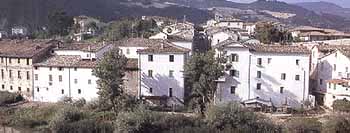
Fossombrone
As the road begins to climb up towards the Apennine mountains, the first stopping place is Fossombrone. This small town, once the Roman Forum Sempronii, looks splendid from afar on the slopes of the Metauro valley. Although it has no single outstanding monument, it is a delightful collection of buildings and streets that bear witness to a prosperous past. The ruins that crown the town are of a castle built by the powerful Malatesta family. The town's centre boasts a pair of arcaded streets lined with modest Renaissance palaces.
After Fossombrone comes the natural highspot of this section of the route, the heady limestone Furlo Gorge. Forget the Cheddar Gorge - it's chalk and cheese compared to this dramatic gorge. If you're travelling along the modern SS3 superstrada turn off at the signs for Furlo rather than taking the 3 km tunnel on the main road. You will now be on the ancient Roman Via Flaminia and in for a treat as you drive through the gorge.
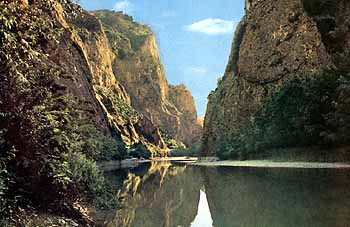
Sheer naked limestone cliffs rise up on either side of the bright green waters of the Candigliano river, leaving just enough room for the narrow road to pass. At one point the ancient highway passes through a tunnel hewn by hand through the hard rock. The work was ordered by Emperor Vespasian in 76 AD - a remarkable feat of Roman civil engineering. You can still see the chisel marks in the rock - if you dare risk being run over in the process. The small village of Furlo at the mouth of the gorge is a good place to eat truffles in season. Or you might hunt out a picnic spot by taking the strada panoramica from the village and climb up to the top of the gorge. But be warned - it's a longish and twisting drive. The area is now a nature park and home to rare flora and fauna; you may even see a golden eagle wheeling overhead. If you're coming from the west, the gorge ends abruptly as the road enters a wide, wooded valley where the Candigliano flows into the Metauro river.
Shortly after the gorge is the village of Furlo with several restaurants serving dishes dressed with local truffles. Also stop to admire the noble Romanesque Abbey of San Vincenzo at the side of the old road.
Part II - The Furlo Gorge
The first town after the gorge is Acqualagna. Badly knocked about during the Second World War, it has little to detain the tourist for most of the year. However, during the last weekend in October and first three weekends in November it is transformed into the "truffle capital" as it hosts the annual Truffle Fair - even before you arrive, the air is permeated with the smell of this exquisite underground fungo.
From Acqualagna the route heads for the medieval town of Cagli, which is well worth pausing to explore. This courtly little town, set against a backdrop of some of the highest peaks in the northern Marches, has welcomed strangers for over two thousand years, since the days when ancient Rome made it an important staging post on the Via Flaminia (one of the oldest and most important Roman roads in Europe). Still today Cagli retains its Roman grid plan that frames a proper central square with a florid fountain, a steely medieval town hall, and huddles of old men deep in gossip.
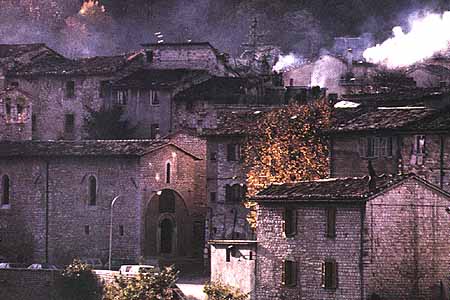
The hand of the great Quattrocento military architect Francesco di Giorgio is unmistakable in the dramatic oval torrione or tower to the west of the piazza, all that remains of the citadel that Urbino's ruling Duke Federico da Montefeltro had built above Cagli towards the end of the 15thC. Search out the pleasing fresco of the Madonna and Child with Saints by Giovanni Santi - the angel to the left of the picture is said to be a portrait of Santi's better known son, Raphael. You will find it in the church of San Domenico near the hospital.
The beauty of Cagli as a town, however, is overshadowed by the natural splendour of its setting amidst some of the northern Marche's most uncontaminated countryside. A tortuous 10 km drive up from the town will take you to the windswept meadows 1108 m up on the summit of Monte Petrano, olympian views and a mass of wild daffodils in late spring (follow signs from near the Torrione).
The road now heads through the dramatic gorge of the Burano river towards Cantiano. Try to take the old Roman road rather than the parallel modern one, stopping to admire the massive stones of the ancient Roman bridge on the way. Cantiano is a good example of an Apennine mountain town, with hard-faced medieval stone houses and an airy main square. It is also known for its horse breeding, and horse meat (carne di cavallo) often features on the menu. The old craft of charcoal burning still takes place in the beech woods that clothe the surrounding slopes.
Leaving Cantiano the modern road fades out, leaving you on the narrow twisting old road just before the junction for the Contessa road which will take you on a 20-minute detour to the medieval gem of a town that is Gubbio. Before turning off, stop to look at the Roman road-building remains at Pontericcioli.
Routes
Tour 1 - The Castles of Montefeltro
Tour 2 - From Paper to Stone
Tour 3 - The Vineyards of Verdicchio
Tour 4 - The Heartland of Le Marche
Tour 5 - In the Shadow of Monte Conero
Tour 6 - The Wild Mountains of the Sybil
Tour 7 - In the Footsteps of Ancient Rome
Tour 8 - Ascoli's Hidden Heritage
Tour 9 - Beside the Seaside
© Liberation Ventures Ltd.